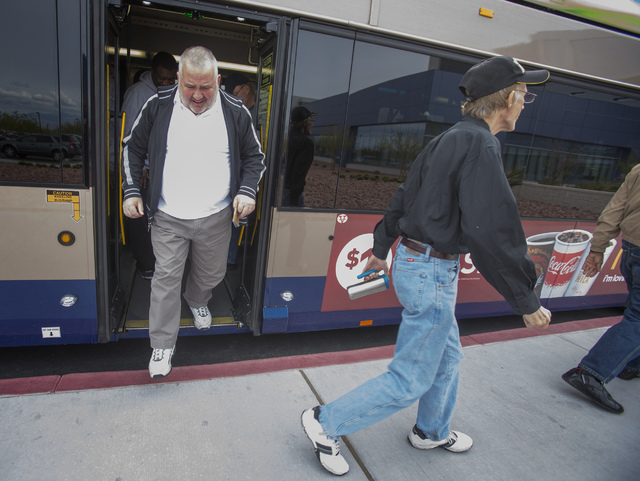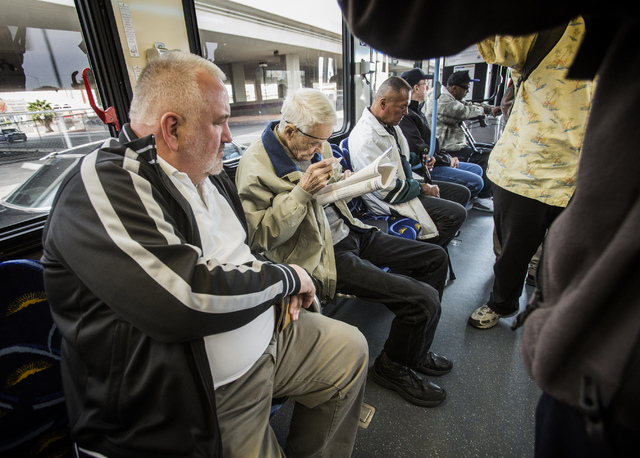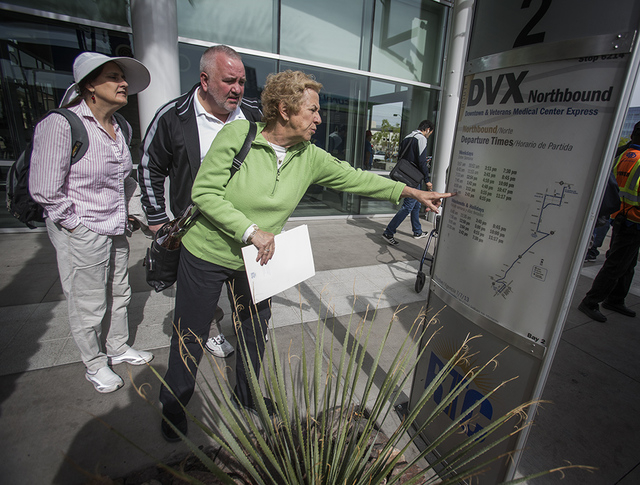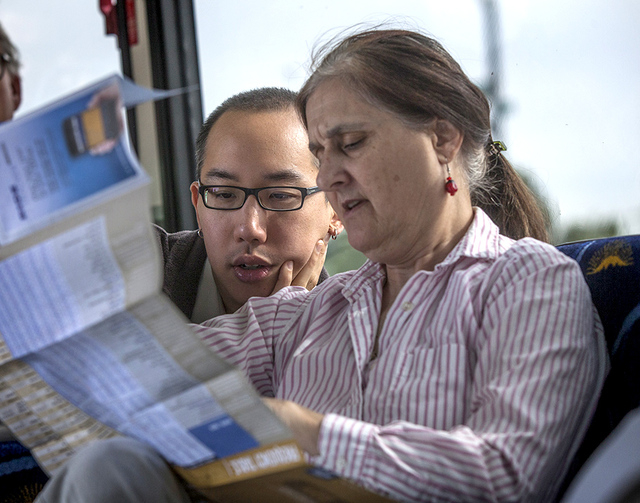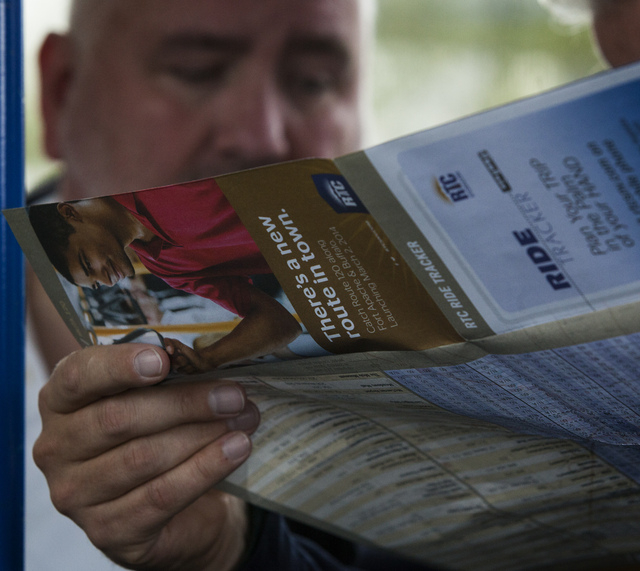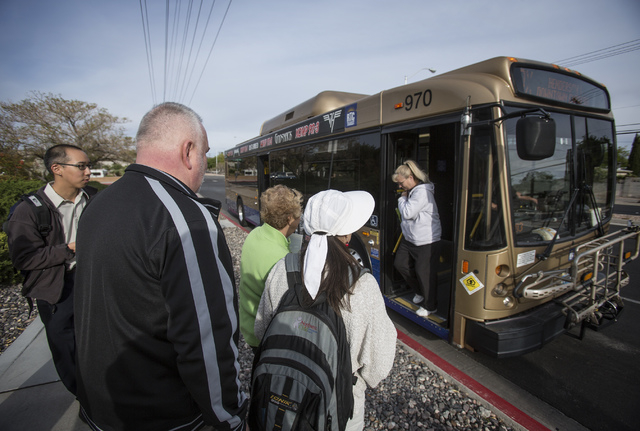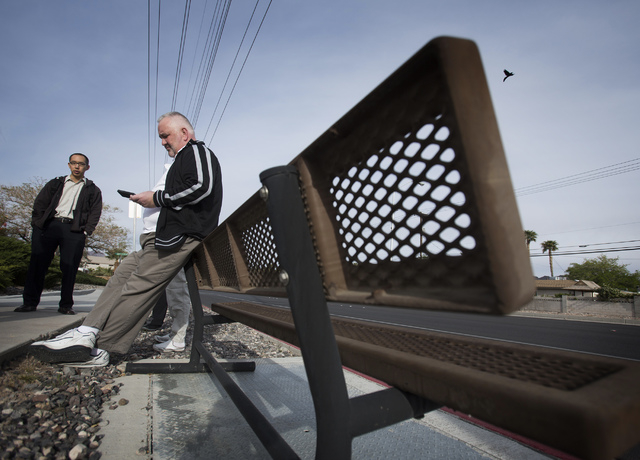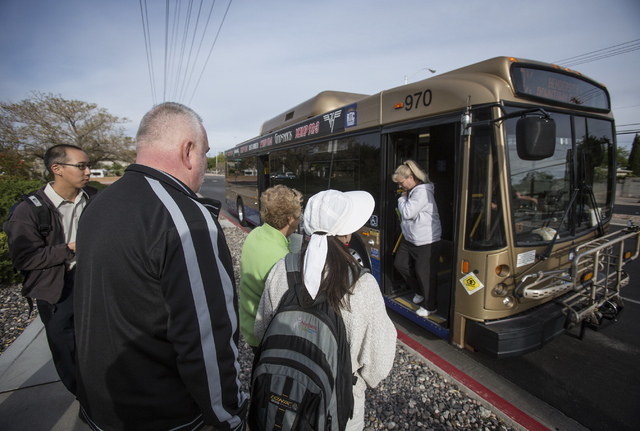Boulder City veterans face another speed bump on trips to new VA Medical Center
The road-weary bus riders were happy to see the hospital come into view after sitting for nearly two hours.
Better yet, they were relieved they didn’t have to walk a mile to get to the front door of the Las Vegas VA Medical Center, a gleaming six-story facility surrounded by desert at the far end of North Las Vegas.
“The good news,” said the Rev. Robert Stoeckig of the Office of the Vicar General of the Roman Catholic Diocese of Las Vegas, one of the bus-riding contingent, “is that the (Regional Transportation Commission) website is wrong. But the bad news is that the website is wrong.”
Stoeckig was referencing a note on one of the commission’s dozens of Web pages that said riders of the Downtown and Veterans Medical Center Express Route would be dropped off at Pecos Road and Tropical Parkway, from where passengers would have had to walk about a mile to the hospital.
The note has since been taken down, and the bus goes all the way to a stop right in front of the medical center.
Stoeckig and five others from Nevadans for the Common Good, a broad-based interfaith coalition of organizations, rode the bus on a recent Friday morning as part of a social science experiment with a purpose.
The objective: to determine how difficult it would be for a veteran living in Boulder City to make a hypothetical 11 a.m. appointment at the VA Medical Center.
The group made the effort to climb into the shoes of Boulder City veterans by walking to a Boulder City bus stop, taking the Henderson and Downtown Express bus to the Bonneville Transit Center in downtown Las Vegas, transferring to the Medical Center Express and, presumably, walking the last mile to the hospital.
Because they didn’t have to make the walk, the end result of the experiment was a success since the group made the “appointment,” arriving at the hospital by 10:30 a.m.
But there were a few anxious moments and the group concurred that on that particular day, they might have been lucky. In addition, the group originally was going to include a representative in a wheelchair who feared the one-mile ending would be too challenging and didn’t make the trip.
HERE COMES THE HITCH
The group started at St. Andrew Catholic Church in Boulder City, taking a quarter-mile walk to the bus stop on Adams Boulevard, one of the main streets through the community.
The Henderson and Downtown Express arrived right on time at 8:17 a.m. The route, listed in Regional Transportation Commission schedules as the “HDX,” goes northwest from Boulder City, passing into Henderson with stops at the Railroad Pass casino, Nevada State College and in three places at the Galleria at Sunset mall.
The bus is scheduled to arrive at the downtown Las Vegas Bonneville Transit Center at 9:47. It’s a tight transfer window — the connecting Downtown and Veterans Medical Center Express is scheduled to leave at 9:51.
After an hour and a half on the bus, riders needed a restroom stop. As it turned out, the driver of the second bus told riders they had time for a break if they made it quick.
“The way we figure it, we were lucky on this trip,” Stoeckig said. “We had a couple of minutes during the transfer, but the Henderson express bus didn’t have to stop very many times on our trip. If we would have had to stop one or two times or if someone in a wheelchair had to get on, which takes a little extra time, we wouldn’t have made the transfer.”
After that 9:51 departure, the next bus to the medical center doesn’t leave for another hour and would have arrived at the hospital well past the 11 a.m. appointment time.
The key takeaway from the experiment was that while the Regional Transportation Commission has made a good effort to accommodate Boulder City veterans, service could be improved. And for an individual in need of medical care, a two-hour trip with about 25 bus stops isn’t much fun, especially if the whole process has to be repeated for the trip home.
The group doesn’t have statistics on how many veterans live in Boulder City, but after meeting several of them in focus groups and one-on-one meetings earlier this year, the group is convinced the need for better service exists.
“We have thousands of retirees here, many of them Air Force veterans,” Stoeckig said. “We have a veterans cemetery here. There’s a skilled nursing center in Henderson.
“But when the hospital opened in 2012, it just made a lot of sense to develop transportation to get there from here as efficiently as possible so we asked ourselves, what can we do to make it more accessible.”
He said another issue is making veterans aware of what’s available.
“I wonder sometimes how many people won’t consider the public transportation option because it’s too difficult,” he said. “In our case, we had someone who didn’t come along because of the long walk at the end that turned out to be misinformation.”
GRIPES HEADED TO COMMISSION
The group plans to take its findings to the Regional Transportation Commission. Boulder City Mayor Roger Tobler is a commission member.
They likely will go to commission staff to present details and see if there’s a way to make improvements.
The group likely will be routed to the specialized transit services group, which oversees door-to-door paratransit services and other special programs.
“The RTC has an open-door policy, and we are always willing to meet with any person or group regarding their transit and transportation service questions or comments,” said Angela Castro, director of government affairs, media and marketing for the commission.
One of the problems of specialized transportation is its cost.
Castro said it costs an average of $2.08 to move a passenger on a fixed route. It costs $36 to move a passenger on a paratransit vehicle. The added costs are a result of the door-to-door service and using specialized equipment and training on the vehicle.
Another option is the Veterans Medical Transportation Network, a program developed after the commission received a federal grant. It’s a one-call, first-come, first-served program specifically for veterans seeking transportation to VA clinics, primary-care physicians and the Veterans Medical Center.
Castro said that option is becoming more widely known with 141 rides given from Boulder City during the first quarter of 2014. Still, that’s less than 1 percent of the total ridership of the program.
Stoeckig said because there are limited rides and seats available, the distance between Boulder City and North Las Vegas results in a small window of time for potential usage. It’s the same problem with other volunteer groups that help veterans. Unless an appointment is in the morning, it’s difficult to get a ride to the hospital and back during the day.
Castro said the commission also can look at adjusting transit departure times on established routes, but an adjustment on one part of the schedule could have a detrimental effect for other riders and their transfers.
Stoeckig said he will bring the results of his experiment back to the Boulder City group for discussion and to consider options before going to the commission.
There was another bright spot on the Boulder City bus experiment.
Robert Hoo, the lead organizer for Nevadans for the Common Good’s elder issues, spotted an advertisement posted on the Henderson express bus. The ad called attention to the tragedies of human trafficking — the first social issue Nevadans for the Common Good became involved with in 2012.
“I’m glad to see that ad,” Hoo said. “It calls attention to a very important issue for Southern Nevada, and I’m glad to see the efforts of our organization resulted in more people learning about it.”
Contact reporter Richard N. Velotta at rvelotta@reviewjournal.com or 702-477-3893. Find him on Twitter: @RickVelotta.



